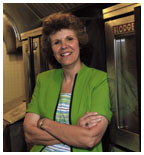Have an opinion about this issue of PAW? Please take a minute to click here and fill out our online survey. It’s an easy way to let the editors know what you like and dislike, and how you think PAW might do better. (All responses will be anonymous.) |
July 6, 2005: A moment with...
(Beverly Schaefer) |
Susan Pierson
At Reunions in May, Dining Services served a record 33,768 meals, the vast majority to be eaten by alumni and family members of the major reunions classes. And for each hoagie, salmon filet, and cheesecake ordered for those tents, there was a corresponding mark in Sue Pierson’s Reunions binder, a 4-inch-thick compilation of forms and spreadsheets. Pierson, an assistant director of residential dining, has coordinated the food for major reunions for the last eight years, with 15-hour workdays while alumni are partying under the tents. (It’s not her only end-of-the-year responsibility — she’s also in charge of food for Class Day and the senior prom.) The Reunions job has become a year-round project. In June, one week after the tents came down, Pierson was already taking phone calls from class officers about Reunions 2006. She spoke recently spoke to PAW’s Brett Tomlinson.
Dining Services seems to be able to create meals and desserts that fit the theme of each reunion. What are some of your favorite examples from the last few years?
A couple of years ago, the 20th-reunion class did a luau theme, and that was a lot of fun. ... We’ve had sculpture cakes made. Last year, I had a bakery that made a sphinx with orange and black stripes on it for an Egyptian theme. Another class had an Arabian nights theme, and we had a cake made that looked like a flying carpet.
Everything at Reunions seems to be orange and black. Does that carry over to the food?
No, not really. Most classes don’t ask for orange and black food. The 25th-reunion class did this year — they wanted to know if we could get orange and black pasta to make pasta salad. But typically, orange and black aren’t really appetizing colors. We make a “tiger cake,” which has thin layers of orange vanilla cake with a chocolate ganache. It’s served Saturday night on the dessert bar. But other than that, I wouldn’t say that we do anything orange and black. I guess people see enough orange and black when they’re looking around that they don’t want to see it on their plates.
Do tastes for Reunions food change, or do classes come back to the same entrees?
Some of the older classes come back [to old favorites]. There’s a sweet-and-sour meatball dish that we keep serving; it’s something that the older classes remember from their time at Princeton. What we’re going to be looking at for next year is doing some more spicy Caribbean foods because that tends to be more popular with some of the younger classes. We try to make the menu a mix. We do steak, which is very popular. We have a chicken and salmon combination, also very popular. We have a pan-Asian meal where we bring in our large gas-fired woks and we actually stir-fry in the courtyards. We also pay even more attention to the vegetarian entrees, especially for the younger classes.
With so many locations to serve and so much food to prepare, do you ever make mistakes?
We ordered a big sheet cake with a pirate ship on it [for the Class of 1985], and we never did find that cake. It was delivered, but we never found it. It was huge — it’s not something you just walk away with. But it just sailed off somewhere.
What are the biggest challenges of feeding alumni and their families at Reunions?
One of the major challenges that we face is bad weather. We’re trying to feed all these people, and unfortunately we don’t have areas to move them inside. We don’t have a dining hall big enough to serve 600 or 700 people, so basically you have to stay under tents. Another challenge has been that as the class numbers continue to grow, the courtyards haven’t grown. We’re being asked to feed more people in locations that aren’t getting any bigger. We haven’t outgrown any places yet, but it’s always easier on a nice night because you can expand out from a tent.
You’ve seen 18 Reunions since you started working at Princeton. Do you have any favorite memories?
Before the 50th reunion a year ago, I got a call from an alum who had some difficulty swallowing. He called to see if he should plan to eat with his classmates. I asked him, “Why wouldn’t you want to eat with your classmates?” and he went on to explain his medical condition. I promised him that he would eat with his class every night, and he did. We made him special food every night. It made us feel really good that we could do that for him, because that’s what Reunions is about — coming and spending time with classmates.
What’s it like managing your own kitchen after Reunions?
I was in the grocery store and cooking again Tuesday, May 31 [Commencement
Day]. I felt bad that my kids hadn’t had a home-cooked meal in several
days. ![]()


